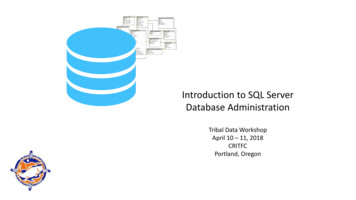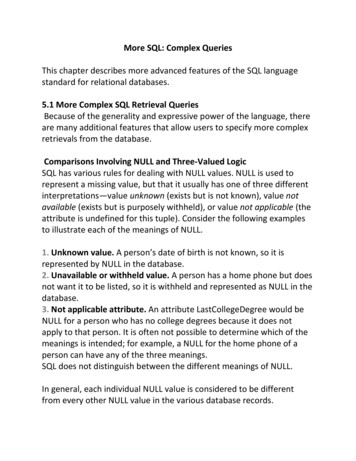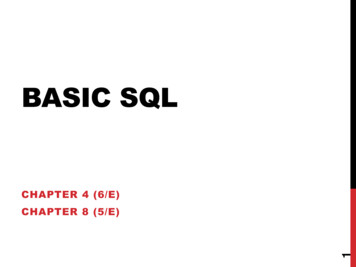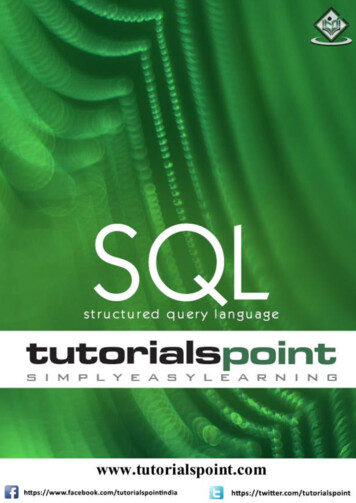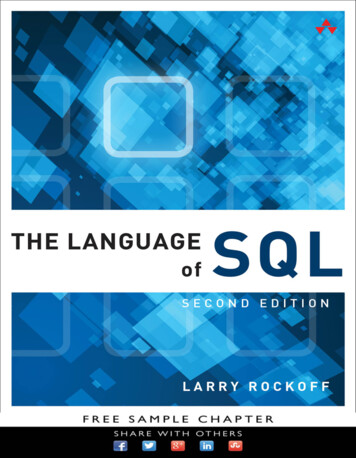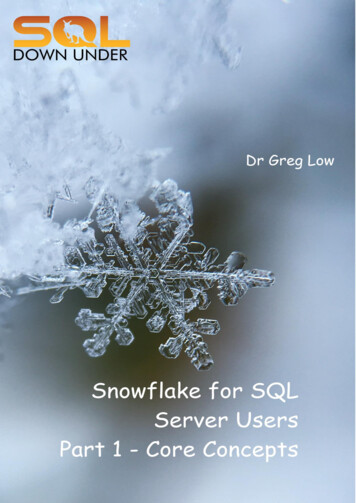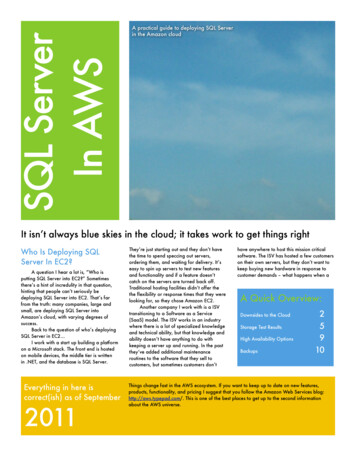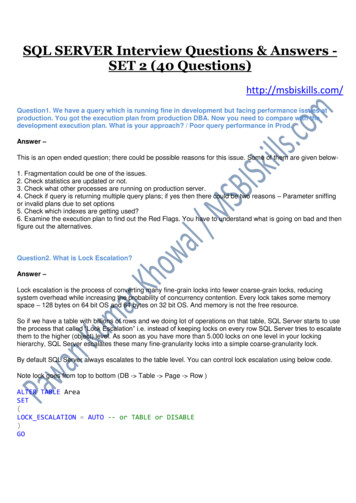
Transcription
Introduction toSQLPhil SpectorIntroduction to SQLPhil SpectorStatistical Computing FacilityUniversity of California, Berkeley
Introduction toSQL
Introduction toSQLWhat is SQL?
Introduction toSQLWhat is SQL?IStructured Query Language
Introduction toSQLWhat is SQL?IStructured Query LanguageIUsually “talk” to a database server
Introduction toSQLWhat is SQL?IStructured Query LanguageIUsually “talk” to a database serverIUsed as front end to many databases (mysql,postgresql, oracle, sybase)
Introduction toSQLWhat is SQL?IStructured Query LanguageIUsually “talk” to a database serverIUsed as front end to many databases (mysql,postgresql, oracle, sybase)IThree Subsystems: data description, data access andprivileges
Introduction toSQLWhat is SQL?IStructured Query LanguageIUsually “talk” to a database serverIUsed as front end to many databases (mysql,postgresql, oracle, sybase)IThree Subsystems: data description, data access andprivilegesIOptimized for certain data arrangements
Introduction toSQLWhat is SQL?IStructured Query LanguageIUsually “talk” to a database serverIUsed as front end to many databases (mysql,postgresql, oracle, sybase)IThree Subsystems: data description, data access andprivilegesIOptimized for certain data arrangementsIThe language is case-sensitive, but I use upper casefor keywords.
Introduction toSQLWhen do you need a Database?
Introduction toSQLWhen do you need a Database?IMultiple simultaneous changes to data (concurrency)
Introduction toSQLWhen do you need a Database?IMultiple simultaneous changes to data (concurrency)IData changes on a regular basis
Introduction toSQLWhen do you need a Database?IMultiple simultaneous changes to data (concurrency)IData changes on a regular basisILarge data sets where you only need someobservations/variables
Introduction toSQLWhen do you need a Database?IMultiple simultaneous changes to data (concurrency)IData changes on a regular basisILarge data sets where you only need someobservations/variablesIShare huge data set among many people
Introduction toSQLWhen do you need a Database?IMultiple simultaneous changes to data (concurrency)IData changes on a regular basisILarge data sets where you only need someobservations/variablesIShare huge data set among many peopleIRapid queries with no analysis
Introduction toSQLWhen do you need a Database?IMultiple simultaneous changes to data (concurrency)IData changes on a regular basisILarge data sets where you only need someobservations/variablesIShare huge data set among many peopleIRapid queries with no analysisIWeb interfaces to data, especially dynamic data
Introduction toSQLUses of DatabasesTraditional Uses:
Introduction toSQLUses of DatabasesTraditional Uses:ILive Queries
Introduction toSQLUses of DatabasesTraditional Uses:ILive QueriesIReport Generation
Introduction toSQLUses of DatabasesTraditional Uses:ILive QueriesIReport GenerationINormalization, foreign keys, joins, etc.
Introduction toSQLUses of DatabasesTraditional Uses:ILive QueriesIReport GenerationINormalization, foreign keys, joins, etc.Newer uses:
Introduction toSQLUses of DatabasesTraditional Uses:ILive QueriesIReport GenerationINormalization, foreign keys, joins, etc.Newer uses:IStorage - data is extracted and analyzed in anotherapplication
Introduction toSQLUses of DatabasesTraditional Uses:ILive QueriesIReport GenerationINormalization, foreign keys, joins, etc.Newer uses:IStorage - data is extracted and analyzed in anotherapplicationIBackends to web sites
Introduction toSQLUses of DatabasesTraditional Uses:ILive QueriesIReport GenerationINormalization, foreign keys, joins, etc.Newer uses:IStorage - data is extracted and analyzed in anotherapplicationIBackends to web sitesITraditional rules may not be as important
Introduction toSQLWays to Use SQL
Introduction toSQLWays to Use SQLIconsole command (mysql -u user -p dbname)
Introduction toSQLWays to Use SQLIconsole command (mysql -u user -p dbname)IGUI interfaces are often available
Introduction toSQLWays to Use SQLIconsole command (mysql -u user -p dbname)IGUI interfaces are often availableIInterfaces to many programming languages: R,python, perl, PHP, etc.
Introduction toSQLWays to Use SQLIconsole command (mysql -u user -p dbname)IGUI interfaces are often availableIInterfaces to many programming languages: R,python, perl, PHP, etc.ISQLite - use SQL without a database server
Introduction toSQLWays to Use SQLIconsole command (mysql -u user -p dbname)IGUI interfaces are often availableIInterfaces to many programming languages: R,python, perl, PHP, etc.ISQLite - use SQL without a database serverIPROC SQL in SAS
Introduction toSQLSome Relational Database Concepts
Introduction toSQLSome Relational Database ConceptsIA database server can contain many databases
Introduction toSQLSome Relational Database ConceptsIA database server can contain many databasesIDatabases are collections of tables
Introduction toSQLSome Relational Database ConceptsIA database server can contain many databasesIDatabases are collections of tablesITables are two-dimensional with rows (observations)and columns (variables)
Introduction toSQLSome Relational Database ConceptsIA database server can contain many databasesIDatabases are collections of tablesITables are two-dimensional with rows (observations)and columns (variables)ILimited mathematical and summary operationsavailable
Introduction toSQLSome Relational Database ConceptsIA database server can contain many databasesIDatabases are collections of tablesITables are two-dimensional with rows (observations)and columns (variables)ILimited mathematical and summary operationsavailableIVery good at combining information from severaltables
Introduction toSQLFinding Your Way Around the ServerSince a single server can support many databases, eachcontaining many tables, with each table having a varietyof columns, it’s easy to get lost when you’re working withdatabases. These commands will help figure out what’savailable:
Introduction toSQLFinding Your Way Around the ServerSince a single server can support many databases, eachcontaining many tables, with each table having a varietyof columns, it’s easy to get lost when you’re working withdatabases. These commands will help figure out what’savailable:ISHOW DATABASES;
Introduction toSQLFinding Your Way Around the ServerSince a single server can support many databases, eachcontaining many tables, with each table having a varietyof columns, it’s easy to get lost when you’re working withdatabases. These commands will help figure out what’savailable:ISHOW DATABASES;ISHOW TABLES IN database;
Introduction toSQLFinding Your Way Around the ServerSince a single server can support many databases, eachcontaining many tables, with each table having a varietyof columns, it’s easy to get lost when you’re working withdatabases. These commands will help figure out what’savailable:ISHOW DATABASES;ISHOW TABLES IN database;ISHOW COLUMNS IN table;
Introduction toSQLFinding Your Way Around the ServerSince a single server can support many databases, eachcontaining many tables, with each table having a varietyof columns, it’s easy to get lost when you’re working withdatabases. These commands will help figure out what’savailable:ISHOW DATABASES;ISHOW TABLES IN database;ISHOW COLUMNS IN table;IDESCRIBE table; - shows the columns and theirtypes
Introduction toSQLVariable TypesSQL supports a very large number of different formats forinternal storage of information.
Introduction toSQLVariable TypesSQL supports a very large number of different formats forinternal storage of information.Numeric
Introduction toSQLVariable TypesSQL supports a very large number of different formats forinternal storage of information.NumericIINTEGER, SMALLINT, BIGINT
Introduction toSQLVariable TypesSQL supports a very large number of different formats forinternal storage of information.NumericIINTEGER, SMALLINT, BIGINTINUMERIC(w,d), DECIMAL(w,d) - numbers with widthw and d decimal places
Introduction toSQLVariable TypesSQL supports a very large number of different formats forinternal storage of information.NumericIINTEGER, SMALLINT, BIGINTINUMERIC(w,d), DECIMAL(w,d) - numbers with widthw and d decimal placesIREAL, DOUBLE PRECISION - machine and databasedependent
Introduction toSQLVariable TypesSQL supports a very large number of different formats forinternal storage of information.NumericIINTEGER, SMALLINT, BIGINTINUMERIC(w,d), DECIMAL(w,d) - numbers with widthw and d decimal placesIREAL, DOUBLE PRECISION - machine and databasedependentIFLOAT(p) - floating point number with p binarydigits of precision
Introduction toSQLVariable Types (cont’d)Character
Introduction toSQLVariable Types (cont’d)CharacterICHARACTER(L) - a fixed-length character of length L
Introduction toSQLVariable Types (cont’d)CharacterICHARACTER(L) - a fixed-length character of length LICHARACTER VARYING(L) or VARCHAR(L) - supportsmaximum length of L
Introduction toSQLVariable Types (cont’d)CharacterICHARACTER(L) - a fixed-length character of length LICHARACTER VARYING(L) or VARCHAR(L) - supportsmaximum length of LBinary
Introduction toSQLVariable Types (cont’d)CharacterICHARACTER(L) - a fixed-length character of length LICHARACTER VARYING(L) or VARCHAR(L) - supportsmaximum length of LBinaryIBIT(L), BIT VARYING(L) - like correspondingcharacters
Introduction toSQLVariable Types (cont’d)CharacterICHARACTER(L) - a fixed-length character of length LICHARACTER VARYING(L) or VARCHAR(L) - supportsmaximum length of LBinaryIBIT(L), BIT VARYING(L) - like correspondingcharactersIBINARY LARGE OBJECT(L) or BLOB(L)
Introduction toSQLVariable Types (cont’d)CharacterICHARACTER(L) - a fixed-length character of length LICHARACTER VARYING(L) or VARCHAR(L) - supportsmaximum length of LBinaryIBIT(L), BIT VARYING(L) - like correspondingcharactersIBINARY LARGE OBJECT(L) or BLOB(L)Temporal
Introduction toSQLVariable Types (cont’d)CharacterICHARACTER(L) - a fixed-length character of length LICHARACTER VARYING(L) or VARCHAR(L) - supportsmaximum length of LBinaryIBIT(L), BIT VARYING(L) - like correspondingcharactersIBINARY LARGE OBJECT(L) or BLOB(L)TemporalIDATE
Introduction toSQLVariable Types (cont’d)CharacterICHARACTER(L) - a fixed-length character of length LICHARACTER VARYING(L) or VARCHAR(L) - supportsmaximum length of LBinaryIBIT(L), BIT VARYING(L) - like correspondingcharactersIBINARY LARGE OBJECT(L) or BLOB(L)TemporalIDATEITIME
Introduction toSQLVariable Types (cont’d)CharacterICHARACTER(L) - a fixed-length character of length LICHARACTER VARYING(L) or VARCHAR(L) - supportsmaximum length of LBinaryIBIT(L), BIT VARYING(L) - like correspondingcharactersIBINARY LARGE OBJECT(L) or BLOB(L)TemporalIDATEITIMEITIMESTAMP
Introduction toSQLCREATE TABLE statementSuppose we have data measured on the height and weightof children over a range of ages. The first step is decidingon the appropriate variable types, and creating the tablewith the CREATE TABLE command.
Introduction toSQLCREATE TABLE statementSuppose we have data measured on the height and weightof children over a range of ages. The first step is decidingon the appropriate variable types, and creating the tablewith the CREATE TABLE command.CREATE TABLE kids(id CHAR(6),race SMALLINT,age DECIMAL(6,3),height DECIMAL(7,3),weight DECIMAL(7,3),sex SMALLINT);
Introduction toSQLEntering observations into a tableWe could now enter individual items with the INSERTcommand:INSERT INTO kids VALUES(100011,2,10.346,148.5,38.95,1);This quickly gets tedious. We can automate the processusing the LOAD DATA command:
Introduction toSQLEntering observations into a tableWe could now enter individual items with the INSERTcommand:INSERT INTO kids VALUES(100011,2,10.346,148.5,38.95,1);This quickly gets tedious. We can automate the processusing the LOAD DATA command:LOAD DATA INFILE ’kids.tab’INTO TABLE kidsFIELDS TERMINATED BY ’\t’;
Introduction toSQLEntering observations into a tableWe could now enter individual items with the INSERTcommand:INSERT INTO kids VALUES(100011,2,10.346,148.5,38.95,1);This quickly gets tedious. We can automate the processusing the LOAD DATA command:LOAD DATA INFILE ’kids.tab’INTO TABLE kidsFIELDS TERMINATED BY ’\t’;This will read an entire tab-separated file into thedatabase in one command.
Introduction toSQLComparison OperatorsIn SQL, the WHERE clause allows you to operate on subsetsof a table. The following comparison operators areavaiable:
Introduction toSQLComparison OperatorsIn SQL, the WHERE clause allows you to operate on subsetsof a table. The following comparison operators areavaiable:IUsual logical operators:
Introduction toSQLComparison OperatorsIn SQL, the WHERE clause allows you to operate on subsetsof a table. The following comparison operators areavaiable:IUsual logical operators: IBETWEEN used to test for a range
Introduction toSQLComparison OperatorsIn SQL, the WHERE clause allows you to operate on subsetsof a table. The following comparison operators areavaiable:IUsual logical operators: IBETWEEN used to test for a rangeIIN used to test group membershipIKeyword NOT used for negation
Introduction toSQLComparison OperatorsIn SQL, the WHERE clause allows you to operate on subsetsof a table. The following comparison operators areavaiable:IUsual logical operators: IBETWEEN used to test for a rangeIIN used to test group membershipIKeyword NOT used for negationLIKE operator allows wildcardsI
Introduction toSQLComparison OperatorsIn SQL, the WHERE clause allows you to operate on subsetsof a table. The following comparison operators areavaiable:IUsual logical operators: IBETWEEN used to test for a rangeIIN used to
Introduction to SQL What is SQL? I Structured Query Language I Usually “talk” to a database server I Used as front end to many databases (mysql, postgresql, oracle, sybase) I Three Subsystems: data description, data access and privileges I Optimized for certain data arrangements I The language is case-sensitive, but I use upper case for keywords.



